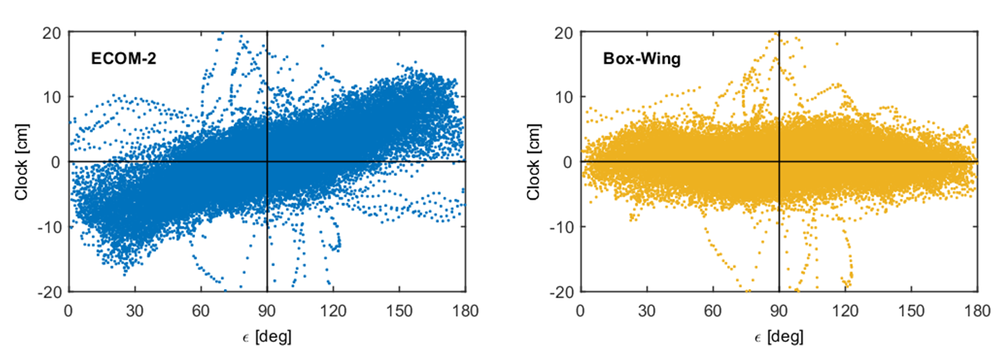Orbit and clock determination of GNSS satellites
High-precision orbit and clock information is a basic requirement for precise positioning with Global Navigation Satellite Systems (GNSSs) such as the American GPS or the European Galileo. Satellite orbits and clocks are determined using observation data from a global GNSS network together with other parameters such as station coordinates, earth rotation parameters and troposphere parameters. Operational orbit and clock products for GPS, GLONASS, Galileo, BeiDou and QZSS are generated at GSOC using the NAPEOS software. A near-real-time solution provides orbit predictions every 3 hours, which are used for the real-time estimation of clock parameters with the RETICLE software.
Radiation pressure modeling
GNSS satellites are subject to a large number of disturbing forces that must be taken into account in orbit determination. The greatest uncertainty is currently due to solar radiation pressure.

This can be taken into account by using empirical parameters or a so-called box-wing model, for example. In this case, the satellite body is modeled as a cuboid and the solar panels as rectangular surfaces. The dimensions and optical properties of these geometric bodies are required to calculate the disturbance acceleration. These are publicly available for the Galileo satellites, for example. For other satellites, these properties must be estimated as parameters or determined empirically.

Figure 2 illustrates the advantages of such a box-wing model compared to the empirical ECOM-2 model for a satellite of the latest GPS III generation. While the residuals of the satellite clock for this model show a clear dependence on the angle epsilon (Sun-Earth-satellite), this systematics disappears when using a box-wing model.
Antenna Thrust

However, very small effects must also be taken into account for maximum accuracy. These include the so-called antenna thrust. This is caused by the transmission of navigation signals and generates a constant acceleration in the radial direction. The transmission power and the mass of the satellite are required for modeling.

In collaboration with the Institute of Communications and Navigation, the transmission power of selected GNSS satellites was measured using the 30 m antenna at the Weilheim ground station. These are shown in Fig. 4 for the different generations of GPS satellites (Block IIA, IIR, IIR-M and IIF). Depending on the satellite type, the transmission power is 20 - 300 watts and influences the satellite orbit in the range of 2 to 30 mm, see Fig. 5.

Further reading
Steigenberger, P., Thoelert, S., & Montenbruck, O. (2020). GPS III Vespucci: Results of half a year in orbit. Advances in Space Research, 66(12), 2773–2785. https://doi.org/10.1016/j.asr.2020.03.026
Steigenberger, P., Thoelert, S., & Montenbruck, O. (2018). GNSS satellite transmit power and its impact on orbit determination. Journal of Geodesy, 92(6), 609–624. https://doi.org/10.1007/s00190-017-1082-2
Darugna, F., Steigenberger, P., Montenbruck, O., & Casotto, S. (2018). Ray-tracing solar radiation pressure modeling for QZS-1. Advances in Space Research, 62(4), 935–943. https://doi.org/10.1016/j.asr.2018.05.036
Montenbruck, O., Steigenberger, P., & Darugna, F. (2017). Semi-analytical solar radiation pressure modeling for QZS-1 orbit-normal and yaw-steering attitude. Advances in Space Research, 59(8), 2088–2100. https://doi.org/10.1016/j.asr.2017.01.036
Montenbruck, O., Steigenberger, P., & Hugentobler, U. (2015). Enhanced Solar Radiation Pressure Modeling for Galileo Satellites. Journal of Geodesy, 89(3), 283–297. https://doi.org/10.1007/s00190-014-0774-0
